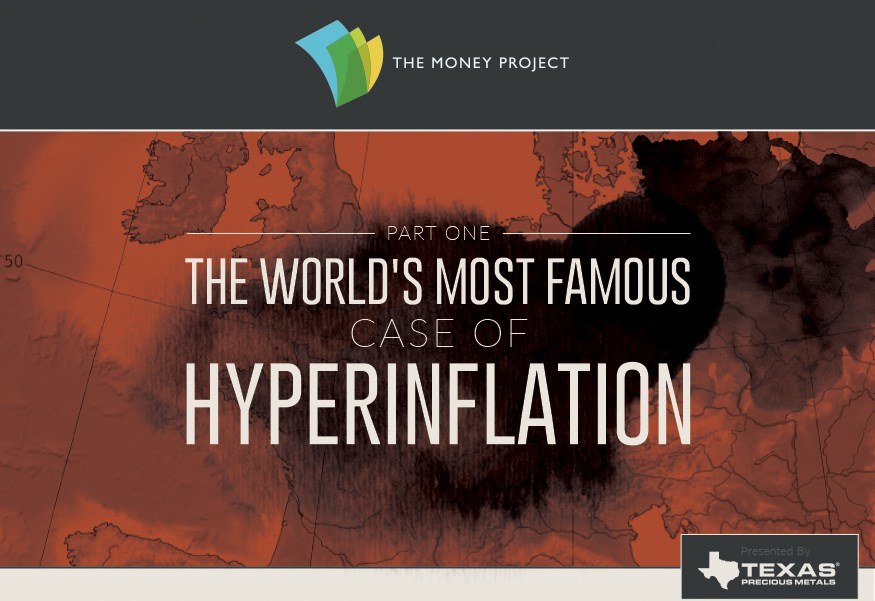The World’s Most Famous Case of Hyperinflation (Part 1)
The Money Project is an ongoing collaboration between Visual Capitalist and Texas Precious Metals that seeks to use intuitive visualizations to explore the origins, nature, and use of money.
The Great War ended on the 11th hour of November 11th, 1918, when the signed armistice came into effect.
Though this peace would signal the end of the war, it would also help lead to a series of further destruction: this time the destruction of wealth and savings.
The world’s most famous hyperinflation event, which took place in Germany from 1921 and 1924, was a financial calamity that led millions of people to have their savings erased.
The Treaty of Versailles
Five years after the assassination of Archduke Franz Ferdinand, the Treaty of Versailles was signed, officially ending the state of war between Germany and the Allies.
The terms of the agreement, which were essentially forced upon Germany, made the country:
- Accept blame for the war
- Agree to pay £6.6 billion in reparations (equal to $442 billion in USD today)
- Forfeit territory in Europe as well as its colonies
- Forbid Germany to have submarines or an air force, as well as a limited army and navy
- Accept the Rhineland, a strategic area bordering France and other countries, to be fully demilitarized.
“I believe that the campaign for securing out of Germany the general costs of the war was one of the most serious acts of political unwisdom for which our statesmen have ever been responsible.”
– John Maynard Keynes, representative of the British Treasury
Keynes believed the sums being asked of Germany in reparations were many times more than it was possible for Germany to pay. He thought that this could create large amounts of instability with the global financial system.
The Catalysts
1. Germany had suspended the Mark’s convertibility into gold at the beginning of war.
This created two separate versions of the same currency:
Goldmark: The Goldmark refers to the version on the gold standard, with 2790 Mark equal to 1 kg of pure gold. This meant: 1 USD = 4 Goldmarks, £1 = 20.43 Goldmarks
Papiermark: The Papiermark refers to the version printed on paper. These were used to finance the war.
In fear that Germany would run the printing presses, the Allies specified that reparations must be paid in the Goldmarks and raw materials of equivalent value.
2. Heavy Debt
Even before reparations, Germany was already in significant debt. The country had borrowed heavily during the war with expectations that it would be won, leaving the losers repay the loans.
Adding together previous debts with the reparations, debt exceeded Germany’s GDP.
3. Inability to Pay
The burden of payments was high. The country’s economy had been damaged by the war, and the loss of Germany’s richest farmland (West Prussia) and the Saar coalfields did not help either.
Foreign speculators began to lose confidence in Germany’s ability to pay, and started betting against the Mark.
Foreign banks and businesses expected increasingly large amounts of German money in exchange for their own currency. It became very expensive for Germany to buy food and raw materials from other countries.
Germany began mass printing bank notes to buy foreign currency, which was in turn used to pay reparations.
4. Invasion of The Ruhr
After multiple defaults on payments of coal and timber, the Reparation Commission voted to occupy Germany’s most important industrial lands (The Ruhr) to enforce the payment of reparations.
French and Belgian troops invaded in January 1923 and began The Occupation of The Ruhr.
German authorities promoted the spirit of passive resistance, and told workers to “do nothing” to help the invaders. In other words, The Ruhr was in a general strike, and income from one of Germany’s most important industrial areas was gone.
On top of that, more and more banknotes had to be printed to pay striking workers.
Hyperinflation
Just two calendar years after the end of the war, the Papiermark was worth 10% of its original value. By the end of 1923, it took 1 trillion Papiermarks to buy a single Goldmark.
All cash savings had lost their value, and the prudent German middleclass savers were inexplicably punished.
Learn about the effects of German hyperinflation, how it was curtailed, and about other famous hyperinflations in Part 2 (released sometime the week of Jan 18-22, 2016).
About the Money Project
The Money Project aims to use intuitive visualizations to explore ideas around the very concept of money itself. Founded in 2015 byVisual Capitalist and Texas Precious Metals, the Money Project will look at the evolving nature of money, and will try to answer the difficult questions that prevent us from truly understanding the role that money plays in finance, investments, and accumulating wealth.
Read more at the original source: http://money.visualcapitalist.com/the-worlds-most-famous-case-of-hyperinflation-part-1-of-2/

